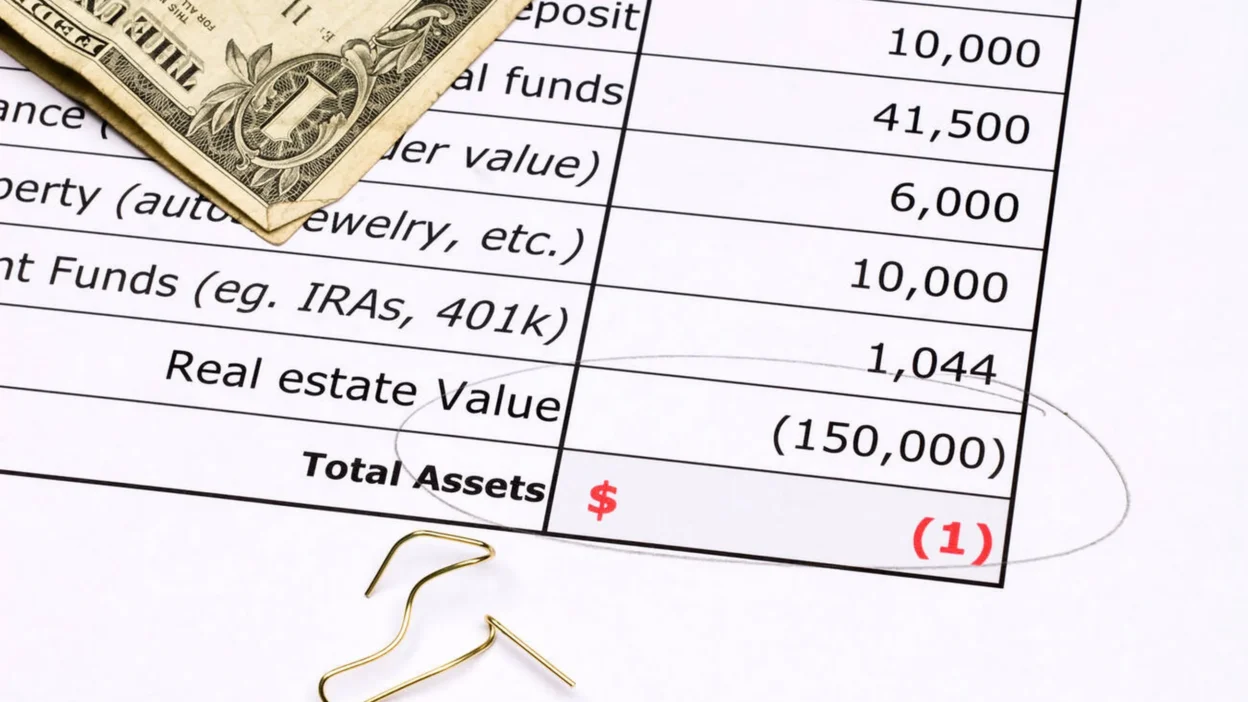Have you ever wondered How Do You Calculate Your Net Worth? Net worth is much more than a single number—it’s a reflection of your entire financial journey, personal finances, and even your perception of wealth. By calculating your net worth using the simple formula
Assets – Liabilities = Net Worth
(= Assets – Liabilities)
you gain a clear measure of wealth that not only shows your current financial position but also highlights the progress you’ve made over time. Whether you’re looking to achieve ambitious financial goals or simply maintain financial stability, understanding your net worth is a critical first step in managing your financial life and cash flow.
Read also : What Percentage of Americans Have a Net Worth of Over $1 Million?
What Are Assets and Liabilities?
Before you can calculate your net worth, it’s essential to know what counts as an asset and what counts as a liability. Let’s break them down:
Assets
Assets are resources you own that provide value or potential future benefit. They contribute to your overall financial standing and include:
- Cash and Bank Accounts:
Your bank accounts (including savings accounts, Cash in savings, and Money market accounts) provide liquidity. Always keep an eye on your Savings account balance and cash deposits to maintain a healthy cash reserve. - Investment Accounts & Financial Assets:
This category includes investment accounts (or types of investment accounts, such as brokerage accounts and additional accounts), individual stocks, and Investment returns from these holdings. Their value is affected by stock prices, rate of return, and the actual market conditions. Use market value estimates and conservative estimates when evaluating these assets. - Retirement Resources:
Retirement accounts, retirement savings, and your overall retirement plan are critical long-term assets. Many also invest in Certificates of deposit, savings bonds, and even annuities Income-producing real estate to boost retirement goals. - Real Estate & Related Properties:
Real estate, including your primary residence, rental property, and even commercial property, counts as an asset. The value of these holdings is determined by the current market and fair market book values. Don’t forget to account for real estate mortgages and the mortgage balance when needed. - Personal Property and Other Valuable Assets:
Items such as Personal property (jewelry, art, collectibles) and precious metals contribute to your asset holdings. A well-rounded collection of assets might also include Business assets, a collection of assets like Common assets, and even cash equivalents like cash deposits, cash rewards, or cash savings. - Additional Resources:
Other assets might include external accounts, additional accounts, and even a cash reserve noted on your personal balance sheet. Evaluating asset liquidation and the balance between assets and liabilities is crucial for assessing Annual asset growth and overall financial progress.
Liabilities
Liabilities are the debts and obligations that reduce your net worth. These include:
- Consumer and Credit-Related Debt:
This category covers credit card debt (including high credit card balances and credit card accounts) and Personal loans. Monitoring your credit score with credit score monitoring tools and reviewing your credit report (as suggested by Consumer Reports) can help manage these obligations. - Loans of Various Kinds:
- Student loans and student loan debt are common liabilities, particularly for young adults.
- Auto loans (with accompanying auto loan bills and auto insurance costs) represent another significant category.
- Be sure to note any installment debts or additional debts that add to your overall debt load.
- Outstanding and Other Debts:
Don’t overlook other outstanding debts such as medical bills, consumer debts, or consumer debt balances. Calculating liabilities—including current debt costs, debt balance, and outstanding balances—is vital. Strategies like the debt avalanche or debt snowball methods can be effective debt repayment and debt reduction strategies. - Mortgages and Related Obligations:
Your mortgage balance and other real estate mortgages represent significant liabilities. The principal balance on these loans must be considered when calculating your net worth. - Other Considerations:
Always review any installment debts, additional debts, or even a debt from student loans when assessing your overall financial situation and determining your current liabilities.

How Do You Calculate Your Net Worth? A Step-by-Step Guide
With a clear understanding of your assets and liabilities, follow these steps to calculate your net worth:
Step 1: List Your Assets
Compile a detailed list of all assets along with their values:
- Cash and Liquid Assets:
Include your cash in bank accounts, savings accounts, Money market accounts, and note the Savings account balance. - Investments and Retirement Resources:
Add values from your investment accounts, Retirement accounts, retirement savings, and any additional resources like savings bonds or Certificates of deposit. - Real Estate and Personal Property:
Account for the market value of your real estate (home, rental property, commercial property) based on current market conditions and market value estimates. Include any Personal property or valuable assets like precious metals and items with conservative estimates of value. - Other Assets:
Don’t forget to include other financial assets such as your brokerage accounts, additional accounts, and even Business assets as part of your collection of assets.
Step 2: List Your Liabilities
Create a list of all your debts and financial obligations:
- Credit and Loan Debts:
Include amounts for credit card debt, credit card balances, Student loans, student loan debt, Auto loans, and Personal loans. Factor in any installment debts or additional debts you may have. - Other Obligations:
Account for outstanding debts like medical bills, consumer debts, and consumer debt balances. Also include the mortgage balance and any other Calculating liabilities like current liabilities.
Step 3: Subtract Liabilities from Assets
Subtract your total liabilities from your total assets to determine your net worth. This calculation gives you a snapshot of your financial position and is a measure of wealth that reflects your Annual asset growth and long-term progress.
For example, if your asset holdings (including your bank accounts, investment accounts, Retirement accounts, and real estate) total up to a significant amount—and after subtracting liabilities such as credit card debt, Student loans, Auto loans, and mortgage balance—you might find that your net worth is growing steadily, demonstrating financial progress toward your financial goals and personal finance goals.

Interpreting Your Net Worth
Once you’ve completed the calculation, your net worth tells you a lot about your financial situation:
- Positive Net Worth:
A positive figure indicates that your assets—including liquid assets, investment returns, and cash flow—exceed your liabilities. This suggests a strong financial position, where your financial life is on a sound, stable track. - Negative Net Worth:
If liabilities like credit card debt, Student loans, and Auto loans outweigh your assets, you have negative net worth. While not ideal, this is common early in your financial journey, especially if you’re managing debt from student loans or installment debts. - Zero Net Worth:
When your assets balance out your liabilities, you’ve reached a break-even point—a milestone that can serve as a baseline for future growth.
Evaluating your net worth can help determine your financial standing and set long-term goals, from boosting emergency savings to planning for retirement goals. Tools like personal balance sheets, Balance sheets, and even online net worth calculators can offer personalized advice and help track your Annual liability growth and Annual asset growth.

Strategies to Improve Your Net Worth
Regardless of your current financial status, there are actionable steps you can take to enhance your net worth:
Increasing Assets:
- Grow Your Savings and Investments:
Work on building your Liquid assets, increasing cash flow, and achieving your savings goal by exploring various savings products in your savings accounts. Diversify your asset holdings by investing in additional investment accounts, including brokerage accounts and Money market accounts. - Boost Retirement and Investment Plans:
Regular contributions to your Retirement accounts, retirement savings, and retirement plan can lead to strong Investment returns over time. Consider exploring various types of investment accounts and investment plans that align with your risk tolerance. Tracking your individual stocks and their stock prices can provide insight into your overall measure of wealth. - Increase Your Income:
Look for ways to boost your annual incomes and anticipated income through raises or side gigs. Evaluating your income tier and Age x pre-tax income may reveal opportunities for a boost in income. Even small improvements can have a lasting impact on wealth over time.
Reducing Liabilities:
- Manage and Reduce Debt:
Develop a strategy to tackle liabilities such as credit card debt, credit card balances, Student loans, student loan debt, Auto loans, and Personal loans. Techniques like the debt avalanche or debt snowball can help lower your debt load. Implement debt reduction strategies and effective debt repayment plans to reduce current debt costs. - Monitor Spending:
Use a budgeting app to monitor discretionary spending and ensure that cash outflows aren’t directed toward nonessentials. Regular discretionary spending budget review can help prevent Lifestyle creep and a costly lifestyle while promoting a current lifestyle that aligns with your financial goals. - Improve Your Credit Profile:
Regularly check your credit score and review your credit report with credit score monitoring tools. Keeping your credit score high can lead to affordable rates on new loans, including auto loans and mortgages, thereby reducing future debt load and current liabilities.

The Role of Technology in Financial Management
Modern technology offers innovative tools to help you track and grow your net worth:
- Budgeting and Financial Tracking:
Utilize a reliable budgeting app to manage your cash flow and monitor both your current asset values and cash equivalents. Online net worth calculators can incorporate data from external accounts and additional accounts for a complete financial picture. - Investment and Market Analysis:
Leverage platforms that provide real-time updates on investment accounts, stock prices, and individual stocks. Monitoring the annual rate of return, actual market conditions, and fair market values (supported by market value estimates and conservative estimates) can help refine your investment plans. - Staying Informed:
Resources such as Consumer Reports and Kelley Blue Book (which provide book values and market value estimates) can offer insights into asset liquidation, the difference between assets, and overall financial progress.

Life Events and Their Impact on Your Financial Situation
Major life circumstances can significantly alter your net worth. Events such as marriage, divorce, job loss, or unexpected medical bills can affect your financial stability:
- Educational and Career Factors:
Your education level (for example, whether you hold a school diploma or even -2022 No high school) may influence your income tier and anticipated income. - Insurance and Protection:
Safeguard your financial future with proper insurance policies, including life insurance, Term life policies, and universal life policies. Consulting an Extension Family Resource Management Specialist from the Department of Extension Family and Consumer Sciences can offer personalized advice. Always review your accessibility statement for any updates related to company retirement or company discounts. - Other Life Events:
Be prepared for a disaster situation by maintaining emergency savings and a cash reserve. Unexpected events—whether they involve medical bills, auto insurance issues, or auto loan bills—can create a financial emergency that may require debt repayment strategies and adjustments to your financial life. In some cases, planning for annuities Income-producing real estate can serve both as an investment plan and a hedge against long-term liabilities.

Additional Considerations for a Complete Financial Picture
Beyond the basics of assets and liabilities, consider these extra factors to refine your personal balance sheet:
- Detailed Analysis of Asset and Debt Components:
Assess your asset holdings by reviewing Balance sheets and comparing the balance between assets and liabilities. Look into asset liquidation possibilities, especially if you experience a decrease in assets over time. - Understanding Your Liabilities:
Delve into Calculating liabilities by examining current liabilities and Annual liability growth. Evaluate installment debts, additional debts, and consumer debts to understand the full extent of your debt load. - Broader Financial Metrics:
Track metrics such as cash deposits, cash rewards, and cash value Bills (or a cash value table) to better understand your cash equivalents and cash outflows. Evaluate the difference between assets, and consider Business assets or a collection of assets to improve your overall financial position. - Wealth and Income Analysis:
Reflect on the perception of wealth, material wealth, and even Spiritual wealth when setting your long-term goals. Resources like BNY Wealth can help you gauge your current wealth, while comparing your median income and Age x pre-tax income offers insight into your boost in income potential. - Other Key Factors:
Finally, consider factors like affordable rates, aspension plans, and the overall cost of a costly lifestyle versus a current lifestyle. Whether you’re reviewing credit card accounts or evaluating external accounts, maintaining an organized personal balance sheet will support your long-term personal finance goals for estate tax purposes.

Conclusion
Your net worth is more than just a snapshot—it’s an evolving reflection of your financial status, financial wellness, and overall financial journey. By understanding and calculating your net worth (using the simple formula Assets – Liabilities), monitoring everything from your bank accounts and savings accounts to your credit card debt, Student loans, Auto loans, and other liabilities, you gain clarity on your financial position. With strategies like debt reduction (using methods such as debt avalanche or debt snowball), enhanced cash flow management, and leveraging technology (through budgeting apps and credit score monitoring tools), you can steadily improve your net worth.
Happy planning, and here’s to your ongoing financial progress and wellness!
Read also : What net worth is considered rich in USA?





